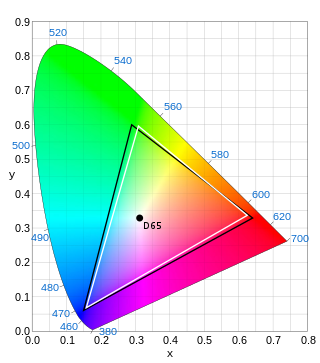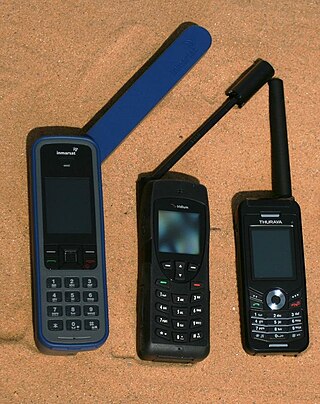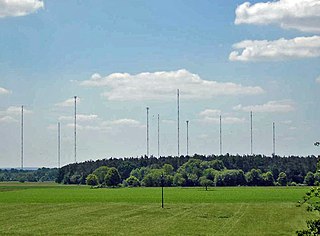
The International Telecommunication Union (ITU) is a specialized agency of the United Nations responsible for many matters related to information and communication technologies. It was established on 17 May 1865 as the International Telegraph Union, significantly predating the UN and making it the oldest UN agency. Doreen Bogdan-Martin is the Secretary-General of ITU, the first woman to serve as its head.

An Earth observation satellite or Earth remote sensing satellite is a satellite used or designed for Earth observation (EO) from orbit, including spy satellites and similar ones intended for non-military uses such as environmental monitoring, meteorology, cartography and others. The most common type are Earth imaging satellites, that take satellite images, analogous to aerial photographs; some EO satellites may perform remote sensing without forming pictures, such as in GNSS radio occultation.
The ITU Radio Regulations (RR) is a basic document of the International Telecommunication Union (ITU) that regulates on law of nations scale radiocommunication services and the utilisation of radio frequencies. It is the supplementation to the ITU Constitution and Convention and in line with the ITU International Telecommunication Regulations (ITR). The ITU RR comprise and regulate the part of the allocated electromagnetic spectrum from 9 kHz to 300 GHz.

Frequency allocation is the part of spectrum management dealing with the designation and regulation of the electromagnetic spectrum into frequency bands, normally done by governments in most countries. Because radio propagation does not stop at national boundaries, governments have sought to harmonise the allocation of RF bands and their standardization.

ITU-R Recommendation BT.601, more commonly known by the abbreviations Rec. 601 or BT.601, is a standard originally issued in 1982 by the CCIR for encoding interlaced analog video signals in digital video form. It includes methods of encoding 525-line 60 Hz and 625-line 50 Hz signals, both with an active region covering 720 luminance samples and 360 chrominance samples per line. The color encoding system is known as YCbCr 4:2:2.
The radio spectrum is the part of the electromagnetic spectrum with frequencies from 3 Hz to 3,000 GHz (3 THz). Electromagnetic waves in this frequency range, called radio waves, are widely used in modern technology, particularly in telecommunication. To prevent interference between different users, the generation and transmission of radio waves is strictly regulated by national laws, coordinated by an international body, the International Telecommunication Union (ITU).

A ground station, Earth station, or Earth terminal is a terrestrial radio station designed for extraplanetary telecommunication with spacecraft, or reception of radio waves from astronomical radio sources. Ground stations may be located either on the surface of the Earth, or in its atmosphere. Earth stations communicate with spacecraft by transmitting and receiving radio waves in the super high frequency (SHF) or extremely high frequency (EHF) bands. When a ground station successfully transmits radio waves to a spacecraft, it establishes a telecommunications link. A principal telecommunications device of the ground station is the parabolic antenna.

As defined by FS-1037C and ITU Radio Regulations, radiodetermination is:
the determination of the position, velocity or other characteristics of an object, or the obtaining of information relating to these parameters, by means of the propagation properties of radio waves

Fixed-satellite service is – according to article 1.21 of the International Telecommunication Union's (ITU) Radio Regulations (RR) – defined as A radiocommunication service between earth stations at given positions, when one or more satellites are used; the given position may be a specified fixed point or any fixed point within specified areas; in some cases this service includes satellite-to-satellite links, which may also be operated in the inter-satellite service; the fixed-satellite service may also include feeder links for other space radiocommunication services.

Spectrum management is the process of regulating the use of radio frequencies to promote efficient use and gain a net social benefit. The term radio spectrum typically refers to the full frequency range from 1 Hz to 3000 GHz that may be used for wireless communication. Increasing demand for services such as mobile telephones and many others has required changes in the philosophy of spectrum management. Demand for wireless broadband has soared due to technological innovation, such as 3G and 4G mobile services, and the rapid expansion of wireless internet services.

The World Radiocommunication Conference (WRC) is a conference organized by the ITU to review and, as necessary, revise the Radio Regulations, the international treaty governing the use of the radio-frequency spectrum as well as geostationary and non-geostationary satellite orbits. It is held every three to four years. Prior to 1993, it was called the World Administrative Radio Conference (WARC); in 1992, at an Additional Plenipotentiary Conference in Geneva, the ITU was restructured, and later conferences became the WRC.

Atmospheric noise is radio noise, or "static", caused by natural atmospheric processes, primarily lightning discharges in thunderstorms. On a worldwide scale, there are about 40 lightning flashes per second, or ≈ 3.5 million lightning discharges per day.

Veena Rawat is an electrical engineer who specializes in telecommunications. Rawat was the first woman to graduate with a PhD in electrical engineering from Queen's University in Kingston, Ontario, Canada. She held executive positions managing programs related to radio frequency spectrum engineering for all wireless and space communication services in the Canadian Government, was the President of the Communications Research Centre (CRC), and was the Vice President and Ambassador to the International Telecommunication Union, for Blackberry, Advanced Technology Division, Canada. In 2014 she was awarded the Officer of the Order of Canada (OC) for her lifetime achievements and contributions at the national and international levels to wireless communications.
An amateur radio satellite is an artificial satellite built and used by amateur radio operators. It forms part of the Amateur-satellite service. These satellites use amateur radio frequency allocations to facilitate communication between amateur radio stations.
One way of outlining the subject of radio science is listing the topics associated with it by authoritative bodies.
Mohamed Ezzedine Mili was a Tunisian diplomat who served as the Secretary-General of the International Telecommunication Union from 1967 to 1982, including an ad interim tenure from 1967 to 1973.

Mobile-satellite service is – according to Article 1.25 of the International Telecommunication Union's Radio Regulations – "A radiocommunication service

Standard frequency and time signal service is, according to Article 1.53 of the International Telecommunication Union's (ITU) Radio Regulations (RR), "A radiocommunication service for scientific, technical and other purposes, providing the transmission of specified frequencies, time signals, or both, of stated high precision, intended for general reception".

Land mobile-satellite service is – according to Article 1.27 of the International Telecommunication Union's (ITU) Radio Regulations (RR) – defined as «A mobile-satellite service in which mobile earth stations are located on land.»

Broadcasting-satellite service is – according to Article 1.39 of the International Telecommunication Union's (ITU) Radio Regulations (RR) – defined as «A radiocommunication service in which signals transmitted or retransmitted by space stations are intended for direct reception by the general public. In the broadcasting-satellite service, the term “direct reception” shall encompass both individual reception and community reception.»













